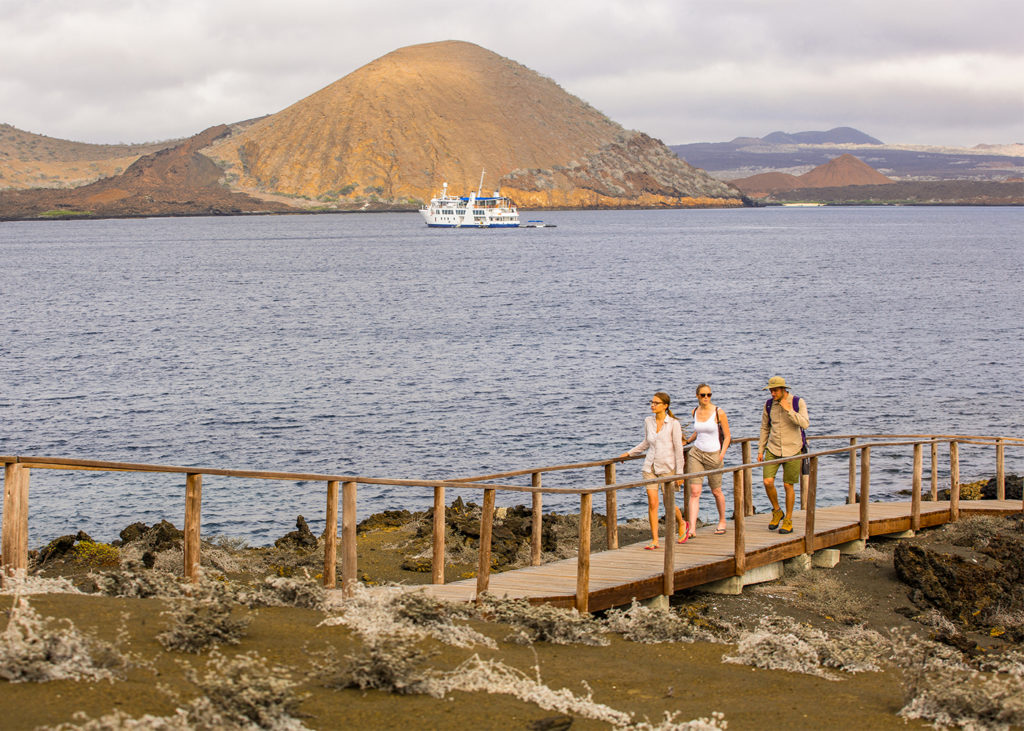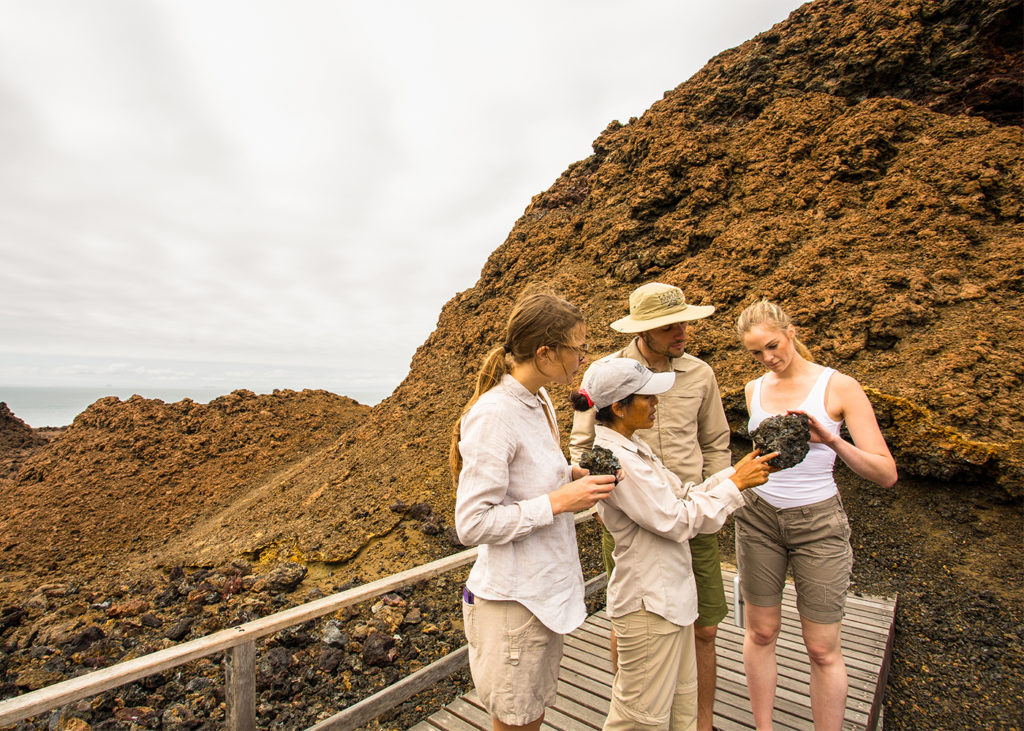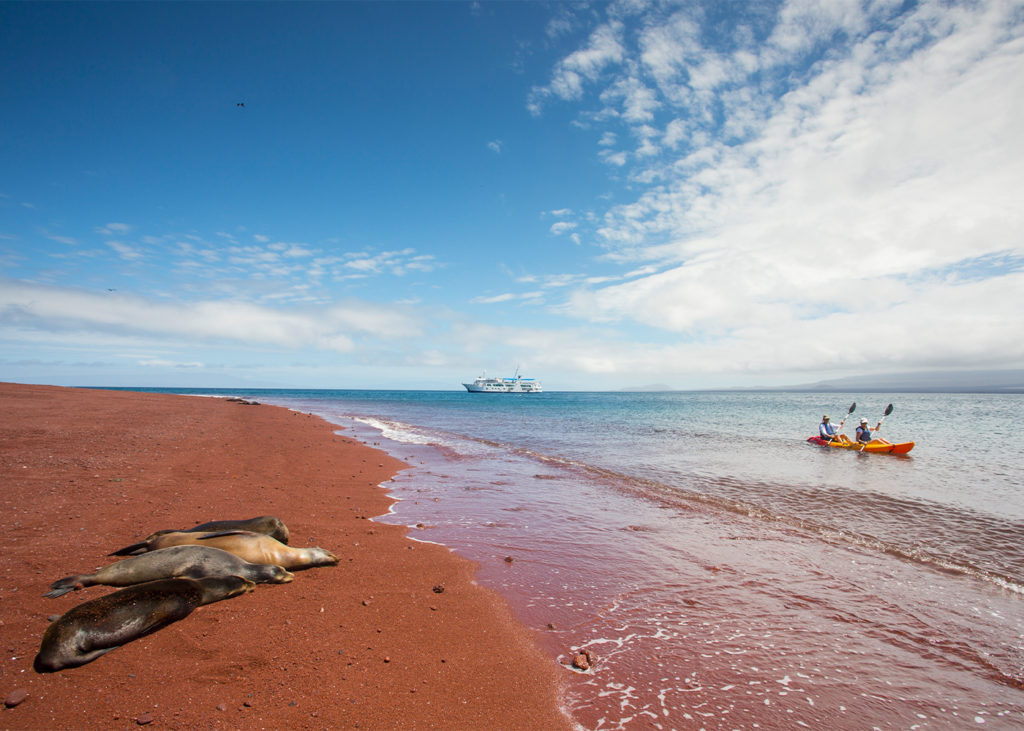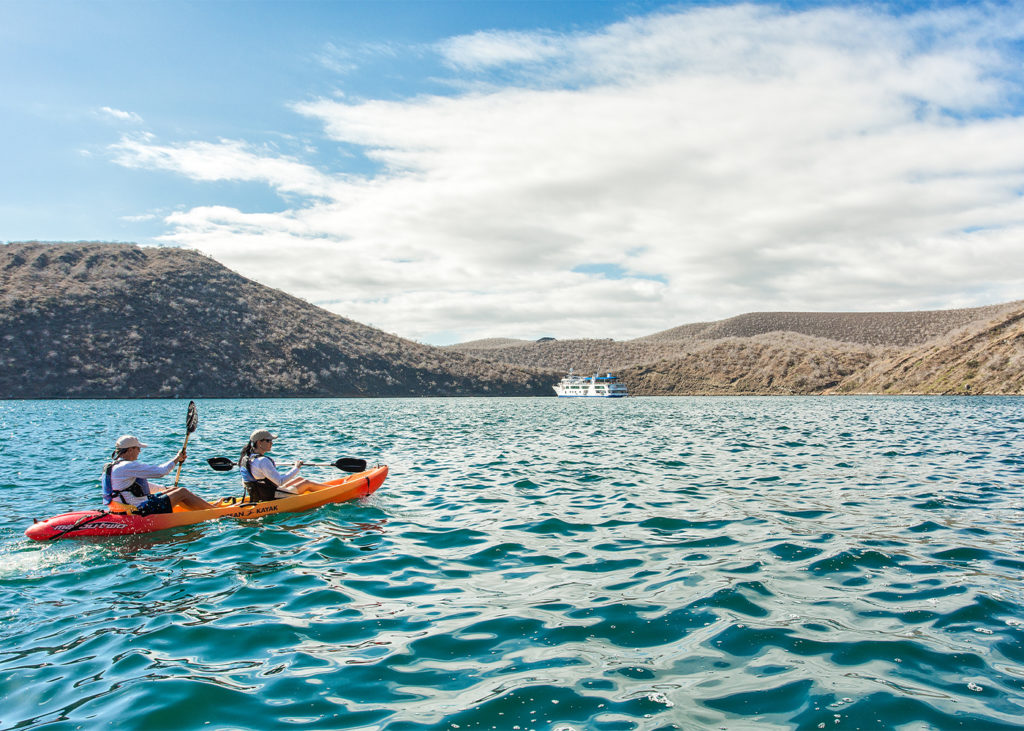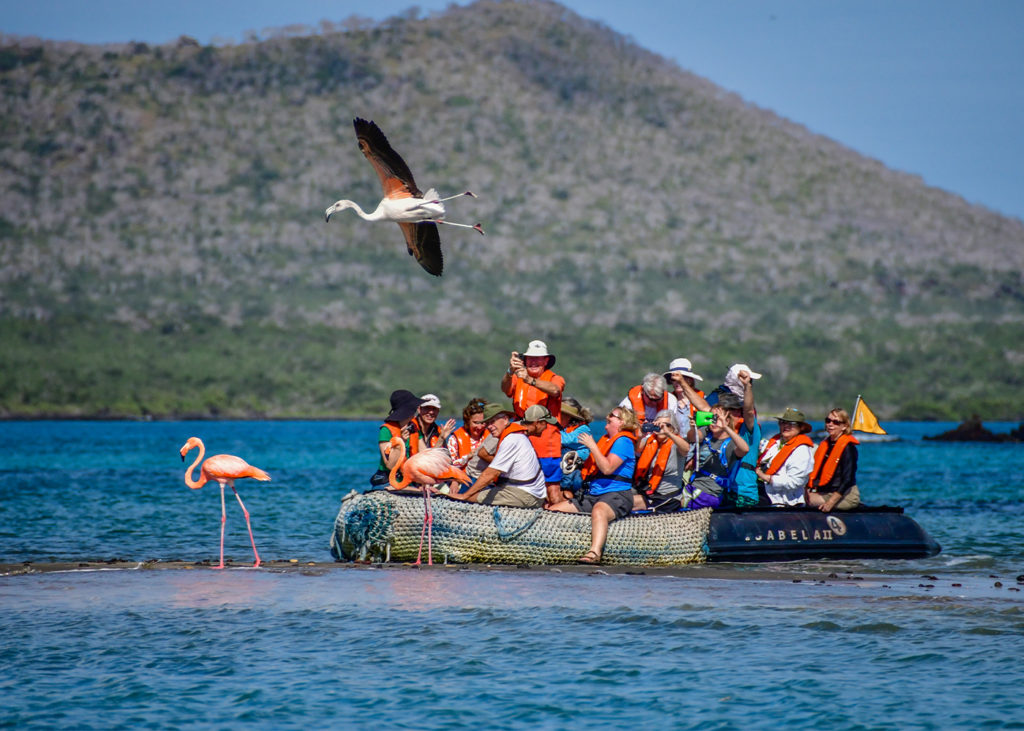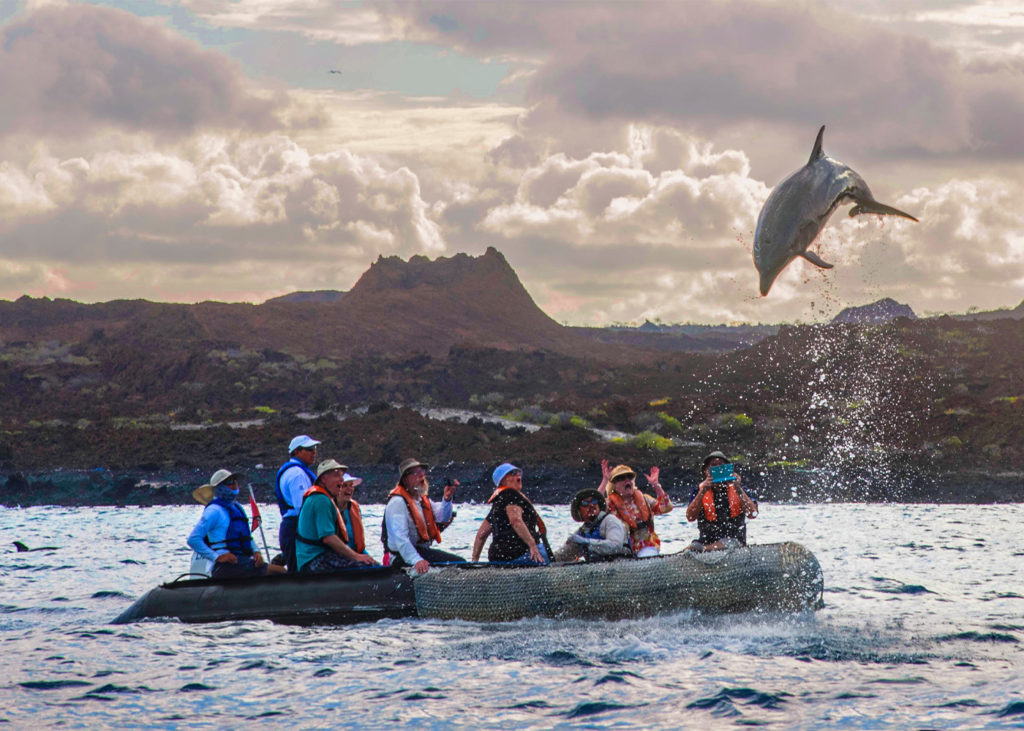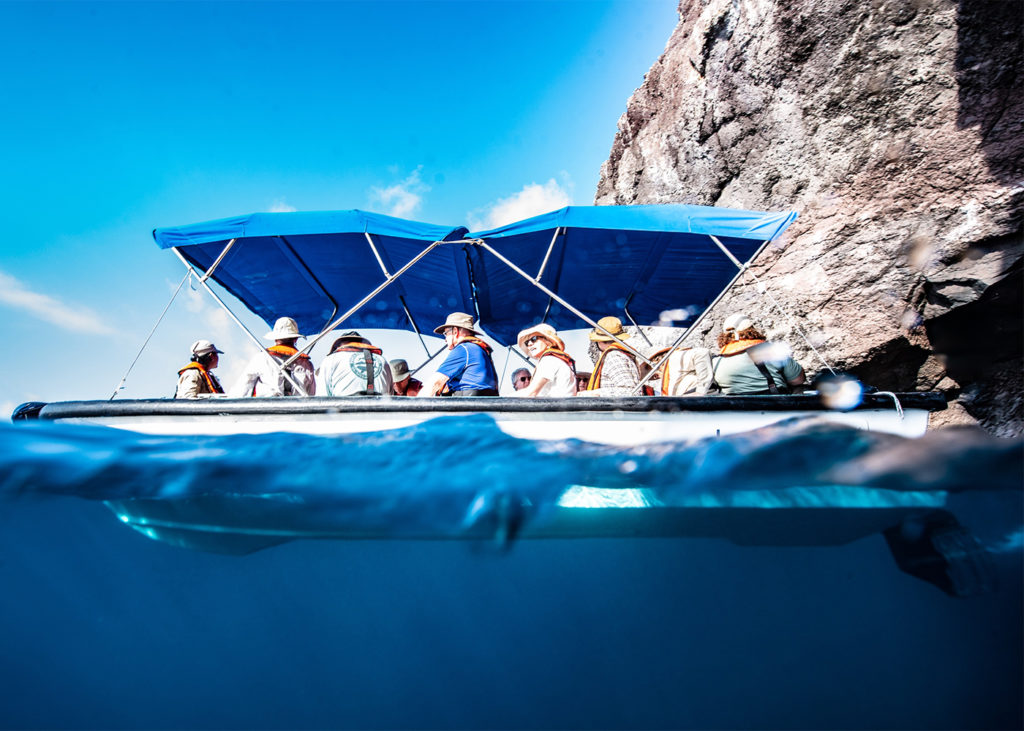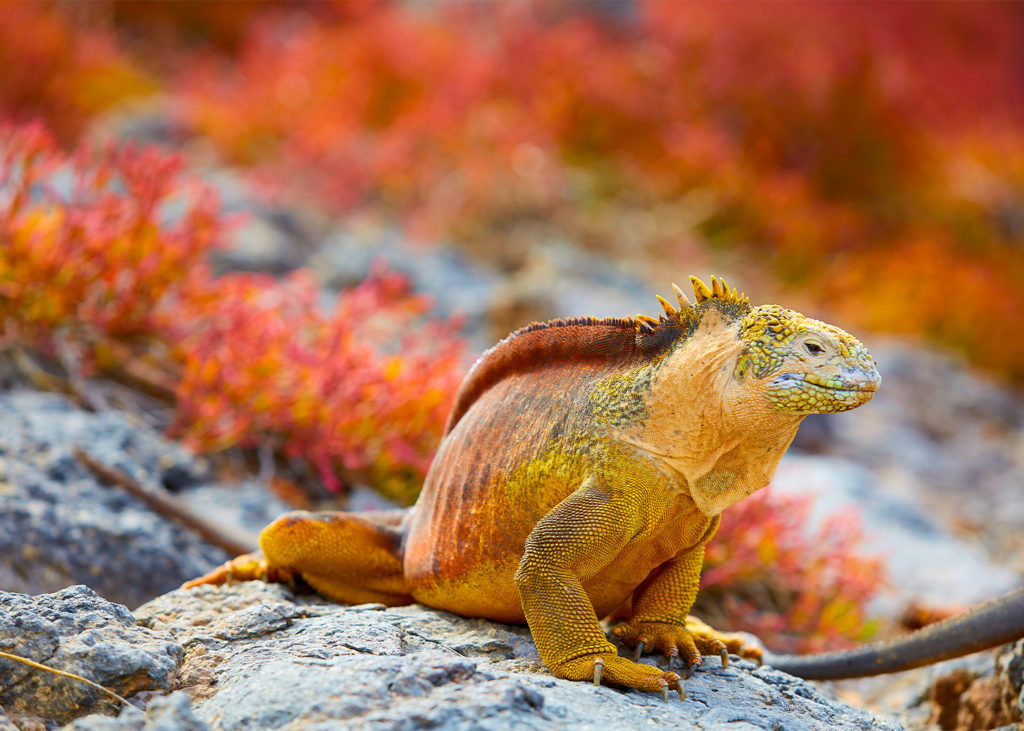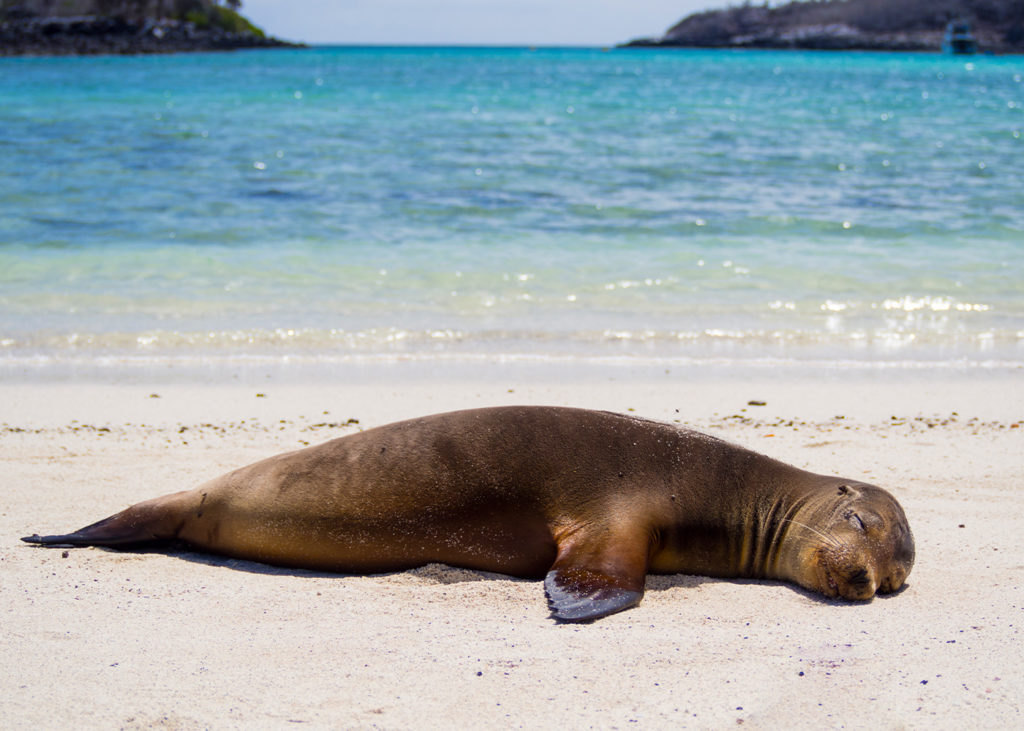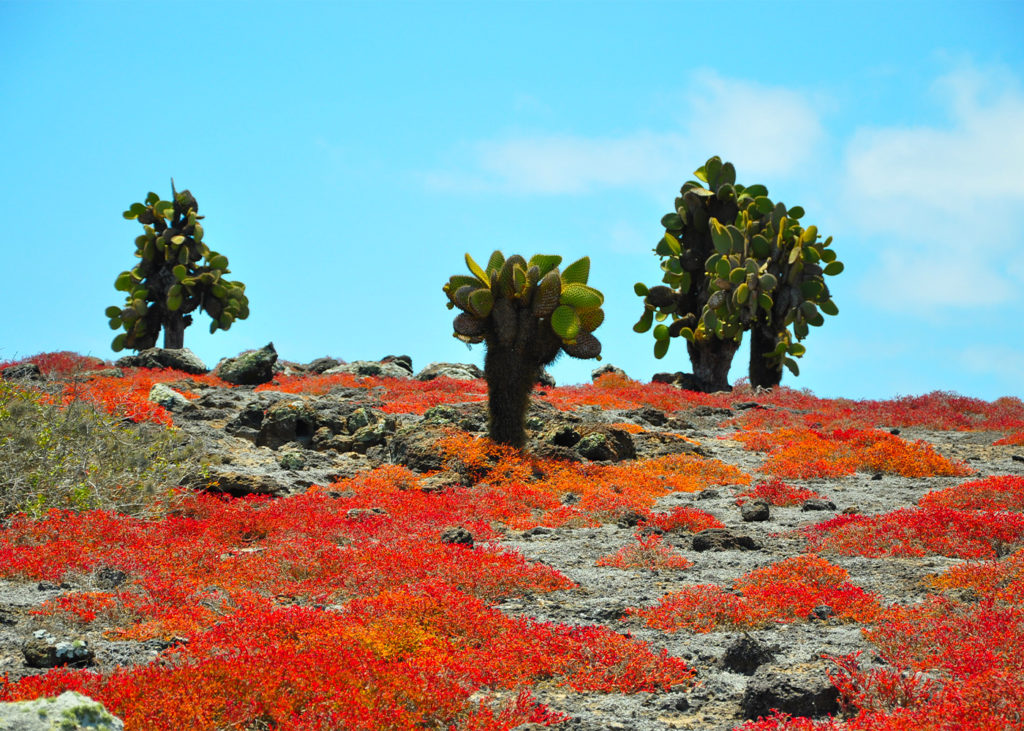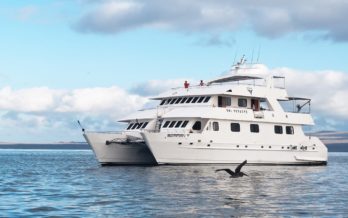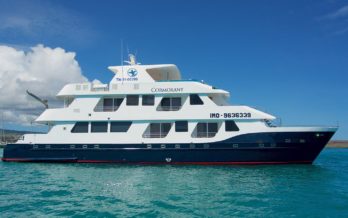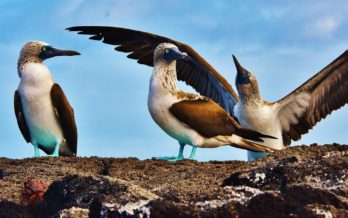Cruise Overview
Yacht Isabela II offers the perfect, intimate space for exploring Darwin’s islands in comfort. Traditionalists will enjoy feeling at home with a crew that has remained almost unchanged for years, leading to seamless attention to detail that will make your stay extra special.
With just 20 guest cabins, the yacht’s convivial atmosphere leads to a close-up experience of this unique world. On board, guests find delicious cuisine, faultless service and excellent facilities, including a Hut Tub, fitness room, bar and outside deck for al fresco meals, drinks, and sunbathing.
As on all our vessels, your groups can expect top facilities and equipment, delicious meals, and safe and stimulating expert-planned expeditions on the islands. Scout the island sites for Big 15 wildlife in groups that average no more than 11-14 guests per naturalist guide which surpass the National Park standard, which permits up to 16 guests per guide. Explore the coast with your guides on our pangas, glass-bottom boat or kayaks, or get wet and snorkel.
Cabin Types
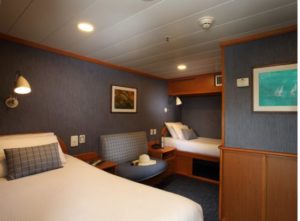
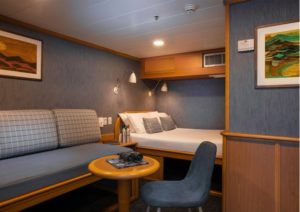
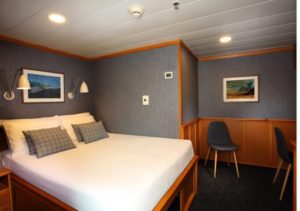
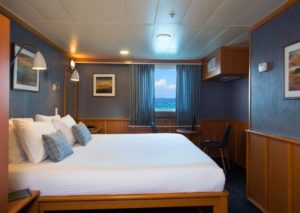
Northern Itinerary
Departs Tuesdays
Puerto Baquerizo Moreno (San Cristóbal Island)
Landing at Puerto Baquerizo Moreno´s airport. Transfer to the dock and Isabela II. Check in, introductory briefing and lunch on board.
Galapaguera Cerro Colorado (San Cristóbal Island)
After lunch, dry landing at Puerto Baquerizo Moreno, and a 40-minute bus ride to the south shore of the island, passing the historical highlands of San Cristobal island. At Cerro Colorado, visit the breeding centre of the highly endangered giant tortoises in the midst of a fantastic deciduous forest, home to dozens of bird species and the endemic San Cristóbal lava lizard. Back on board late afternoon for a welcome cocktail, briefing and dinner.
Prince Philip’s Steps (Tower/Genovesa Island)
Overnight navigation northbound to the incredible bird island, Genovesa, crossing the equator on the way. The morning starts with a very interesting panga ride along the cliffs and then disembark (dry landing) on rocks for a steep climb (90 feet) up some stairs. Once at the top of the stairs, the land is flat, allowing for a stimulating walk of about a mile to the other side of this small island, observing large colonies of Nazca boobies, red footed boobies, great frigate birds and storm petrels. Those not wishing to disembark can enjoy a longer panga ride along the cliffs. Snorkelling is possible, paddling kayaks, or riding the glass bottom boat. Lunch on board.
Darwin Bay (Tower/Genovesa Island)
In the afternoon, a wet landing for an easy stroll observing several species of birds, mainly frigate birds, red footed boobies, Nazca boobies, lava gulls, swallow-tailed gulls, herons, finches and mockingbirds. Optional walk over sharp lava and uneven terrain for dramatic views, or else return to the beach to enjoy swimming and snorkelling at this beautiful natural harbour. Expedition plan for Thursday and dinner.
Buccaneer Cove (James/Santiago Island)
After breakfast, enjoy a coastal exploration along the impressive cliffs of Buccaneer Cove. Learn about the history of Santiago Island, its relevance for the whalers, pirates and early researchers, including Darwin’s epic voyage in 1835, and the conservation projects aimed at eradicating feral species (a fence stretched along the rocky outcrop is visible to save native plants from the once existing enormous goat population). Today the island is free of feral goats, and the cove is home to a large number of marine birds, sea lions and inter-tidal organisms. Enjoy fantastic natural formations such as the “Elephant Rock”, “The Bishop” and an impressive natural cave. This is a great site for snorkelling too! Lunch on board.
Puerto Egas (James/Santiago Island)
Puerto Egas was only briefly inhabited in the 20th century in an attempt to commercialize salt from a deposit inside a tuff cone. Today, Puerto Egas is one of the most impressive coastal walks in Galápagos (wet landing). Most of the landscape is tuff-stone layers and lava flows. This is a great opportunity to see land and marine birds. At low tide, marine iguanas graze upon the algae beds and there is also a colony of fur-sea lions which can be observed up-close. Opportunity for snorkelling and swimming from the beach after the walk. Expedition plan for Friday and dinner.
Punta Espinoza (Fernandina Island)
During the night the yacht sails over to the north shore of Isabela Island, crossing the equator twice in the process. The morning brings us to the youngest island of the archipelago, Fernandina. Disembark (dry landing) for a one-mile walk. Punta Espinoza has an amazing combination of barrenness with lots of wildlife. Having no introduced mammals, Fernandina has a very unique environment with the highest density of marine iguanas, sharing their space with sea lions, sally light-foot crabs, hawks, penguins and the flightless cormorant. Snorkelling is a refreshing reward near the lava shores of Fernandina. Lunch on board.
Tagus Cove (Isabela Island)
Across the narrow Bolívar Channel, on the northwest of Isabela, lies secluded Tagus Cove. The deep cove provided a favourite anchorage for pirates and whalers over the centuries. Old graffiti is still found carved on its walls. The vegetation in the area includes the fragrant palo santo (torchwood) trees. These white-barked trees are leafless and look dead most of the year. They leaf and spring back to life in the wet season.
An optional uphill hike takes guests to the back of Darwin Crater, filled with salt water. The view at the end of the trail is worth the climb. Darwin is one of Isabela’s six volcanoes, a remarkable contrast to the lower islands to the east of the archipelago. All guests will enjoy a panga ride along the volcanic cliffs of Tagus Cove, teeming with life (boobies, flightless cormorants, penguins, martins, terns, iguanas and sea lions). Here there are possibilities to swim, snorkel or ride kayaks. There is no beach in the area, so pangas are employed. Expedition plan for Saturday and dinner.
Urbina Bay (Isabela Island)
After breakfast (wet landing) disembark at Urbina Bay, located at the foot of volcanoes Alcedo and Darwin, western Isabela Island, the result of an uplifting of the ocean in 1954. Here you can find corals, shells, and many other calcareous organisms exposed above water. This area is also home to large and very colourful Galápagos land iguanas, giant tortoises (occasionally); a good spot to observe Darwin’s finches. Along the shoreline, after the hike, guests may encounter flightless cormorants and see penguins while snorkelling in this beautiful cove. Lunch on board.
Punta Vicente Roca (Isabela Island)
Depending on the conditions of the ocean, it will be possible to schedule a snorkelling outing along the cliffs of partly-sunken Ecuador Volcano, on the northern tip of Isabela Island. Since there is no landing site at this location, the coastal exploration is by dinghy, while the naturalist guide explains the dramatic geology of the area with remains of lava flows and tuff stone layers. This is the nesting place for flightless cormorants, the only existing marine birds in the world other than penguins that have changed their condition of flying birds to diving birds. Wildlife here also includes sea lions, Galápagos fur seals, Galápagos penguins, blue-footed and Nazca boobies and noddy terns. This area boasts an impressively-rich marine life, and is seasonally visited by green sea turtles and oceanic sun fish (Mola mola). If conditions are good, snorkelling can be done at the cliffs of a tuff cone. Expedition plan for Sunday and dinner.
Rábida Island (Jervis)
Disembark at Rábida Island (wet landing) on a red-coloured beach, due to the unusually high content of iron in the volcanic material. A gratifying stroll along the beach of this small island (1.9 sq. mi.) allows the observation of a large colony of sea lions, marine iguanas, mockingbirds, yellow warblers and several species of Darwin’s finches. Very close to the beach, hidden behind a strip of green saltbush, is a salt pond where at times greater flamingos migrate. This is a great place to snorkel from the beach, both for beginners as well as for experienced snorkelers, due to the unique combination of underwater species and submarine landscapes. Non snorkellers will enjoy the glass bottom boat, a panga ride along the coast or paddle out on a sea kayak. During navigation to our next island, dolphins and/or whales are often spotted. Lunch on board.
Cerro Dragon (Dragon Hill) (Santa Cruz Island)
The north shore of Santa Cruz hosts Cerro Dragon (Dragon Hill). Dry landing and a walk that includes a brackish water lagoon frequented by lagoon birds, including stilts, pintail ducks, sandpipers, sanderlings, and more. Further inland, the trail offers a beautiful view of the bay and the western islands of the archipelago. This area is a natural nesting site for land iguanas, constantly monitored and assisted by the Charles Darwin Research Station. The arid-zone vegetation can be a rewarding location for bird watching, where Darwin’s finches, Galápagos mockingbirds, the endemic Galápagos flycatcher, and yellow warblers are regular sightings. Snorkelling or swimming is possible out of the beach near the landing site. Farewell cocktail and departure briefing before dinner.
Central Itinerary
Departs Mondays
Southern Itinerary
Departs Friday
Tour Inclusions
- Shore excursions led by Expedition Team
- Fleet of zodiacs for adventures ashore
- Accommodation
- All meals
- Conferences and lectures
- Visits to the islands mentioned in the itinerary
- Transportation to / from the airport in Galápagos
- Snorkelling equipment
- Water
- Internet and WiFi * Due to the Galápagos’ remote location, internet connections are intermittent and low-bandwidth.
Tour Exclusions
- Flights to Galapagos Islands
- Galapagos National Park admission fee approx. US$100
- Galapagos Transit Control Card approx. US$20 per person
- Tips
